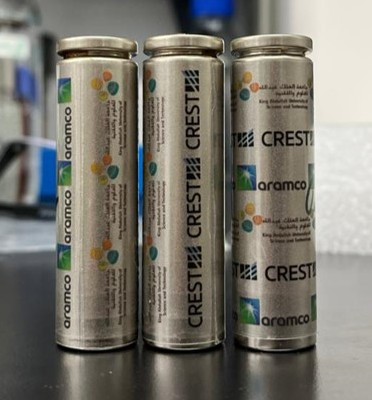Hot Batteries: KAUST develops energy storage solutions for KSA's extreme temperatures

King Abdullah University of Science and Technology (KAUST) is forging a close partnership with industry leader Aramco to develop extreme temperature-resilient batteries designed for subsurface applications and the intense heat of Saudi Arabia, as well as cooler and even frigid shelf conditions — a revolutionary advancement in the realm of “hot” batteries catering to diverse operational conditions.
“Together, we’re poised to overcome the most pressing technological hurdles facing the energy industry,” said Dr. Muhammad Arsalan, lead of the Advanced Sensing and Robotics team at Aramco’s Exploration and Petroleum Engineering Center (EXPEC). He added that Aramco’s ingrained operational expertise complements KAUST's cutting-edge research capabilities.
Professor Husam Alshareef, Chair of the KAUST Center of Excellence for Renewable Energy and Storage Technologies (CREST) and KAUST's principal investigator for the project on “Batteries for Hot Environments,” said his Center is proud to work with Aramco on addressing critical downhole and environmental issues. “The key challenge lies in identifying electrolytes and separators that can endure high temperatures,” he noted, highlighting the innovative work ahead.
Although traditional rechargeable lithium-based batteries have become the preferred choice for powering a wide range of devices and tools, they generally degrade at temperatures above 60 C, making them hardly suitable for subsurface applications in oil and gas wells, where temperatures typically range between 65 and 200 C. However, in collaboration with Aramco, KAUST is working on overcoming this challenge by developing new all-climate batteries that can effectively operate from subzero to 130 C range.
“The technology will not only lead to considerable cost savings for upstream oilfield applications but can also improve battery performance in grid systems, electric vehicles (EVs) and related applications by minimizing cooling requirements, extending battery lifetime and alleviating safety concerns, thereby driving efficiency and reliability across multiple sectors,” said Alshareef.

KAUST and Aramco collaborate on advanced battery technologies built to endure extreme temperatures.
Research teams at KAUST and Aramco are developing these new batteries for specific subsurface energy-production purposes. However, in parallel, they also aim to develop new electrodes and electrolytes that can boost the high-temperature stability and volumetric energy density of lithium-ion batteries within the 10-80 C range for unmanned autonomous vehicles (UAVs), which also have excellent potential for both grid storage and EVs.
With the growing battery market, including the entire supply chain, expected to reach US400 billion by 2030, Alshareef noted, KAUST aims to develop the best possible battery lifecycles to thrive in harsh environments. “This is just the beginning; basically, we anticipate that the batteries are going to be dominant in the Kingdom sooner or later, so we need to prepare for that.”
The KAUST-Aramco initiative, which has also drawn collaborative interest from other local and international investors, aligns with Saudi Vision 2030 aspirations and Research, Development and Innovation Authority (RDIA) priorities, emphasizing technological advancements and sustainable energy solutions that drive economic diversification and address regional environmental challenges.
Resilience matters
Dr. Jehad El-Demellawi, R&D and Operations Manager of CREST, and Aramco’s former lead of this project, highlighted the challenges stemming from the dependence of subsurface oilfield tools on nonrechargeable batteries, often resulting in frequent and substantial replacement costs due to the finite energy capacity of these batteries. While rechargeable alternatives exist, they fall short in terms of the durability and performance needed to thrive in extreme conditions.
“Overcoming these challenges through state-of-the-art battery technologies can drive significant improvements in efficiency, performance and sustainability across various industries, including subsurface oilfield applications,” El-Demellawi said. He further emphasized that this collaboration is focused on achieving two bold objectives: long-term high-temperature resilience and enhanced energy density — goals that are seldom realized in rechargeable batteries.
Remarkably, El-Demellawi highlighted, in less than a year the Aramco-KAUST joint team had developed several high-temperature battery systems and advanced their technology readiness level from concept to full-scale operational prototypes while achieving significant innovation leaps. These groundbreaking, fully assembled rechargeable batteries, coming in different formats (i.e., coin, pouch, and cylindrical), were capable of performing across an impressive temperature range and not just hot temperatures — from subfreezing to more than 130 C.
Recently, El-Demellawi noted, Energy & Environmental Sciences featured one of the team’s novel technologies on new nonflammable rechargeable lithium-sulfur batteries that reliably operate across an unprecedented temperature range from –20 C to 100 C. This achievement is a testament to the harmonious Aramco-KAUST partnership and exemplifies an exceptional maturity in bridging the gap between industry and academia.
Dr. Dong Guo, the lead author of this published work, emphasized that lithium-sulfur batteries, with their high specific capacity, are among the most promising energy-dense battery technologies. More importantly, he added, their moderate voltage window provides a unique opportunity to develop stable and safe batteries for high-temperature applications.
“Over the past year, the high-temperature batteries group at CREST has developed different functional electrolytes and electrode materials designed for batteries operable and storable at extreme temperatures,” Guo said, adding that the developed commercial-scale batteries had been continuously operating at 130 C for nearly eight months with excellent capacity retention.
El-Demellawi noted: “As we continue enhancing our batteries’ operational temperature range and performance over the coming years, we will simultaneously work on their scale-up, field-testing and deployment. Additionally, we will address other relevant critical challenges, including the need for rapid charging capabilities for optimized efficiency in field operations and ensuring the compatibility of the developed batteries with existing equipment and legacy infrastructure.”
Dr. Ghaithan Al-Muntasheri, Director of Aramco’s EXPEC, said: “The cutting-edge thermal management technologies and materials science innovations through the Aramco-KAUST partnership are unlocking new frontiers in energy storage, ensuring reliable performance even under the most extreme temperature conditions.” He emphasized that EXPEC will continue collaborating with KAUST to drive further technological breakthroughs.
Charging ahead
“The energy sector simply lacks reliable rechargeable batteries for elevated temperatures,” Arsalan said, pointing out that overcoming issues of high-temperature stability, energy density, charge-discharge cycles, and low self-discharge requires a synergistic approach between industry and academia. “The key lies in developing novel battery chemistries incorporating suitable electrolytes, separators, and packaging designs to work seamlessly at elevated temperatures.”
High-temperature batteries could reduce reliance on single-use primary batteries, improving subsurface applications’ costs and carbon footprints. He added that the high costs associated with replacing downhole batteries amplify the economic benefits of adopting “intelligent-well” technologies. In the current project, KAUST and Aramco researchers strive to advance cylindrical-cell prototypes operating at 130 C for hundreds of cycles, maintaining energy density for one-year periods.
The engineering of batteries that can remain stable at higher temperatures reduces cooling requirements and saves energy in various applications beyond oil and gas production, including grid systems and the EV market, suggested Alshareef. “In addition, with such engineered electrolytes, the battery lifetime can be maintained or optimized for harsh weather conditions. Similarly, battery safety can be enhanced by making nonflammable batteries that can withstand higher temperatures.”
While downhole battery applications in the upstream energy sector represent a persistent challenge for operators, Dr. AbdulWahab AlGhamdi, Head of Aramco's Upstream Research Center at KAUST, said the joint efforts between Aramco and KAUST “push research boundaries beyond limits” toward unleashing full potential within the battery domain.

